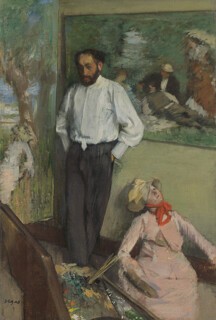If you walk through the main galleries of the Fitzwilliam Museum in Cambridge just now you’ll find yourself on a creepy treasure hunt. A one-legged mannequin on a crutch rests near Titian’s Tarquin and Lucretia. A pair of legs in suit trousers and shiny shoes, with bowler hat appended, reclines opposite a Signorelli. By Millais’s The Bridesmaid a long blonde wig has been suspended from an easel; a dummy’s hand on an articulated metal arm holds a hairbrush, paused part way down the iconic Pre-Raphaelite hair. In front of the Poussins a wooden box containing miniature wax figures has a peephole – like a camera obscura with the picture inside. It’s a reconstruction of the ‘grande machine’ Poussin used to stage his paintings: he would move the models and furniture around on his miniature platform to get the perspective right and see how the light struck the arrangement. The figures in the replica box have been set up – in tribute – to mimic the composition of Poussin’s Extreme Unction, one of his Seven Sacraments series, which the Fitzwilliam recently acquired at a cost of several million pounds.
All these toys – entertainments commissioned by the curator Jane Munro – are a prelude to the museum’s current big exhibition, Silent Partners: Artist and Mannequin from Function to Fetish (until 25 January), a show that begins by being about the mannequins, or lay figures, that artists often used as technical aids. More pliable, and more patient, than live models, many of them were also compelling and strange. A primitive lay figure once owned by Walter Sickert is stretched out on a sheet in a large cardboard coffin; it’s as though we’d stumbled on the Tin Man’s corpse. Made with enormous wooden joints and ball sockets pinned with metal bolts, it’s a ghoulish-looking thing. Sickert bought it in 1929; he thought it had once been owned by Hogarth, and was proud of its lineage. He had a local undertaker wrap it in a shroud and used it to create three versions of The Raising of Lazarus. This wasn’t just about getting the arms and legs to look right.
François-Pierre Guillois’s articulated wooden skeleton from around 1800 is another weird, robotic-looking creature, made of wood, metal and string. It is anatomically quite precise and can assume the positions of a living body; its forearms are two wooden bones that simulate the radius and the ulna and it has fingers that individually open and close. Paris led the way in mannequin-making from the second half of the 18th century, endeavouring to re-create the human form in as lifelike a way as possible and producing far more sophisticated models than Sickert’s creature. Paul Huot, who worked between the 1790s and 1820s, was one of the masters. A female mannequin he sold for a fortune to the genre painter August von der Embde is included in the show; X-rays have revealed a skeleton made of wood and metal, the skeleton covered in a mixture of horsehair and tow (to simulate flesh), which is in turn covered with a double layer of cotton stockinette (for skin). The mannequin is shapely, with a slight swell to the stomach and buttocks. The upper chest and neck are made of wax and its head is papier-mâché, with rouged cheeks and painted eyes. The top of its head is pierced with holes so that a wig or hat can be fixed on top. Huot signed his name on the mannequin’s throat (the head, once slotted into place, hides the signature). It was delivered to von der Embde along with a three-page instruction booklet. This included advice on how to mount the mannequin on its stand and pin its arms and thighs into place. Detailed instructions on how to make it pose like the Venus de’ Medici were given, along with a recommendation to comb the model’s hair regularly to prevent moths laying their eggs in it. Millais seems to have hired a Huot-like mannequin – ‘Child no. 98’, on show here, with its pretty head sitting beside its body – to make a pair of paintings of his young daughters, Waking and Sleeping. The pout of the sleeping girl’s mouth, the flush on her cheek: she couldn’t look more alive, but the look is copied from the perfect flush on the doll’s perfect face.
Willing these things into life was hard. Degas’s Portrait of Henri Michel-Lévy (c.1878) shows the painter Michel-Lévy in a studio with two of his canvases behind him, his palette abandoned. A woman in a bonnet is slumped stiffly at his feet, her face roughly painted. She looks up at something outside the painting’s frame; her elbows and arms stick out at unnatural angles – she resembles the broken puppet she is. Yet her pose mirrors that of a woman leaning against a tree in one of the canvases in the background. Degas is making a teasing point about the academic artifice of Michel-Lévy’s landscapes, drawing attention to their origins in the studio. But there is also a suggestion of violence in the painting; the mannequin collapsed at the painter’s feet – while he stands over it with his hands in his pockets – hints at some prior act of frustrated rage.
There is also playfulness. In the 1920s the British painter Alan Beeton, who worked for a while with Sickert, produced a series of paintings in which his mannequin appears in its own form: undressed, in just its stockinette skin, and contorted into a variety of positions. Posing shows the mannequin in a formal, upright position in the studio. Composing shows it leaning forward at a table, writing in a notebook, seemingly lost in concentration. Reposing has the figure flopped in a chair, one arm hanging down towards the floor. In Decomposing the mannequin has been decapitated. Bits of stuffing poke out; it looks like it’s in its death throes. The original mannequin was found two years ago in the workshop of one of Beeton’s relatives, moth-eaten, with a smashed nose and broken fingers. For the Fitzwilliam show it has been restored, and is exhibited seated on a chair at a table in the centre of a small side-room; the paintings from the series are hung on the walls around the reconstructed tableau. Entering the room is like wandering onto a macabre stage set.
In the second half of the 19th century, mannequins changed; they became dressmakers’ and shop-window dummies, dolls to be adored and cared for. The French dollmakers intended their dolls to be multi-purpose, for children to play with as well as artists. The bébé dolls made by Jumeau had wooden bodies with ball joints so they could bend, and bisque heads with glass eyes and wigs. One of the dolls is exhibited here with its original wardrobe: pretty cotton underclothes, smart knitted socks, leather shoes, an elaborate silk and lace dress, velvet coat and matching hat with feather, as well as a small fur muff for her hands. In 1889 Thomas Edison produced the first phonograph doll. She has a bisque head too, but an ugly metal torso punctured with holes through which she ‘speaks’. Take off her pink dress and you find she is half-doll, half-machine, and terrifying to look at. Small cylinders inside her play the disembodied voices of young girls. You can listen to a tinny recording of her reciting ‘Little Jack Horner’ at the Fitzwilliam; it sounds like someone speaking from beyond the grave. Edison’s factory was set up to produce a hundred thousand talking dolls a year. They didn’t catch on – hardly surprising – and the business collapsed after a year.
Dolls became fetishised and sexualised. Oskar Kokoschka’s Self-Portrait at the Easel features a doll propped up beside the painter. The painter himself appears hunched; his head is oversized and his arm and hand are twisted into an unnatural position: he is the distorted mannequin, bending in unnatural ways. The doll next to him, by contrast, seems to have all the right proportions. She looks up at him impassively while he appears to pinch her naked thigh. For Kokoschka, the figure of the doll was linked to his muse, Alma Mahler. After their two-year affair ended he commissioned a life-sized replica from the dollmaker Hermine Moos, but the doll didn’t live up to the real woman, and at a drunken party he destroyed it. The doll’s head was discovered in his garden the next day stained with red wine, like blood.
Send Letters To:
The Editor
London Review of Books,
28 Little Russell Street
London, WC1A 2HN
letters@lrb.co.uk
Please include name, address, and a telephone number.


